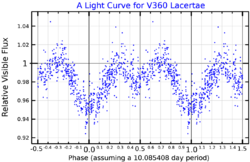Astronomy:14 Lacertae
| Observation data Equinox J2000.0]] (ICRS) | |
|---|---|
| Constellation | Lacerta |
| Right ascension | 22h 50m 21.77721s[2] |
| Declination | +41° 57′ 12.1795″[2] |
| Apparent magnitude (V) | 5.91[1] |
| Characteristics | |
| Spectral type | B3IV:eaV[3] (B4 + F9 III)[4] |
| U−B color index | −0.508[1] |
| B−V color index | +0.083[1] |
| Variable type | β Lyr[3] |
| Astrometry | |
| Radial velocity (Rv) | −15.8±3.1[5] km/s |
| Proper motion (μ) | RA: +6.047[2] mas/yr Dec.: +1.124[2] mas/yr |
| Parallax (π) | 2.0147 ± 0.1990[2] mas |
| Distance | 1,600 ± 200 ly (500 ± 50 pc) |
| Orbit[6] | |
| Period (P) | 10.085415±0.000080 d |
| Eccentricity (e) | 0.0 |
| Periastron epoch (T) | 2441170.285±0.029 |
| Semi-amplitude (K1) (primary) | 25.8±1.7 km/s |
| Semi-amplitude (K2) (secondary) | 159.2±0.2 km/s |
| Details[1] | |
| 14 Lac A | |
| Mass | 7.45±0.3 M☉ |
| Radius | (polar) 7.55 R☉ |
| Surface gravity (log g) | 3.55 cgs |
| Temperature | (Polar) 18,000±1,000 K |
| 14 Lac B | |
| Mass | 1.21±0.05 M☉ |
| Radius | (polar) 8.85 R☉ |
| Surface gravity (log g) | 2.65 cgs |
| Temperature | (polar) 6,000±200 K |
| Other designations | |
| Database references | |
| SIMBAD | data |
14 Lacertae is a binary star[1] system in the northern constellation Lacerta, located around 1,600 light years away.[2] It has the variable star designation V360 Lacertae;[7] 14 Lacertae is the Flamsteed designation. The system is barely visible to the naked eye in good seeing conditions, having a peak apparent visual magnitude of 5.91.[8] It is moving closer to the Earth with a heliocentric radial velocity of −16 km/s.[5]
This is a double-lined spectroscopic binary in a close, circular orbit with a period of 10.08 days and a separation of 40.327 R☉ (28.055 Gm). The orbital inclination is 65°±1°. 14 Lac is a variable star system that, once per orbit, shows a primary minimum with a 0.07 magnitude decrease and a secondary minimum with a decrease of 0.02. The primary component is a Be star that is spinning rapidly at its critical velocity. The lower mass secondary is synchronously rotating and is filling its Roche lobe. The rapid rotation of the primary may have been caused by mass transfer from the secondary.[1]
Samus et al. (2017) classify this as a detached Beta Lyrae-type eclipsing binary, although they note there is some uncertainty in the classification.[3] Bossi et al. (1998) argued that the system is neither an eclipsing binary nor an ellipsoidal variable. Instead they propose the variability is caused by distortion of a gaseous shell by the secondary component.[9] Linnell et al. (2006) demonstrated that the light curve is mostly caused by tidal distortion in combination with illumination of the lower mass secondary by the primary.[1]
References
- ↑ 1.0 1.1 1.2 1.3 1.4 1.5 1.6 1.7 "Properties and nature of Be stars. 24. Better data and model for the Be+F binary V360 Lacertae", Astronomy and Astrophysics 455 (3): 1037–1052, September 2006, doi:10.1051/0004-6361:20053792, Bibcode: 2006A&A...455.1037L.
- ↑ 2.0 2.1 2.2 2.3 2.4 2.5 Brown, A. G. A. (August 2018). "Gaia Data Release 2: Summary of the contents and survey properties". Astronomy & Astrophysics 616: A1. doi:10.1051/0004-6361/201833051. Bibcode: 2018A&A...616A...1G. Gaia DR2 record for this source at VizieR.
- ↑ 3.0 3.1 3.2 Samus, N. N. et al. (2017), "General Catalogue of Variable Stars", Astronomy Reports, 5.1 61 (1): 80–88, doi:10.1134/S1063772917010085, Bibcode: 2017ARep...61...80S.
- ↑ Harmanec, P. et al. (January 2015), "Properties and nature of Be stars. 30. Reliable physical properties of a semi-detached B9.5e+G8III binary BR CMi = HD 61273 compared to those of other well studied semi-detached emission-line binaries", Astronomy & Astrophysics 573: 17, doi:10.1051/0004-6361/201424640, A107, Bibcode: 2015A&A...573A.107H.
- ↑ 5.0 5.1 Gontcharov, G. A. (November 2006), "Pulkovo Compilation of Radial Velocities for 35495 Hipparcos stars in a common system", Astronomy Letters 32 (11): 759–771, doi:10.1134/S1063773706110065, Bibcode: 2006AstL...32..759G.
- ↑ Hill, G. et al. (August 1997), "Properties and nature of Be stars. 17. V360 Lac = HD 216200 is a B3e + F9IV: binary", Astronomy and Astrophysics 324: 965–976, Bibcode: 1997A&A...324..965H.
- ↑ 7.0 7.1 "14 Lac". SIMBAD. Centre de données astronomiques de Strasbourg. http://simbad.u-strasbg.fr/simbad/sim-basic?Ident=14+Lac.
- ↑ Malkov, O. Yu. et al. (February 2006), "A catalogue of eclipsing variables", Astronomy and Astrophysics 446 (2): 785–789, doi:10.1051/0004-6361:20053137, Bibcode: 2006A&A...446..785M, http://elar.urfu.ru/bitstream/10995/73280/1/10.1051-0004-6361-20053137.pdf
- ↑ Bossi, M. et al. (February 1998), "14 Lacertae: A case of shell-orbit coupling?", Astronomy and Astrophysics Supplement 127 (3): 433–444, doi:10.1051/aas:1998112, Bibcode: 1998A&AS..127..433B
 |


